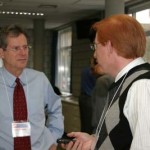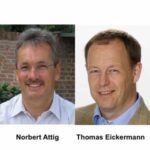In this video from the Dell EMC HPC Community meeting, Hugo Falter from Par-Tec describes the company’s software contribution to the 5 Petaflop booster Dell EMC supercomputer coming the Julich Supercomputing Center. “ParaStation MPI software from ParTec will be used to keep the new Booster system running efficiently. The resiliency-related extensions of ParaStation MPI support fine-grained recovery of parallel application tasks.”
How Par-Tec Software will Power the 5 Petaflop Dell EMC Booster Supercomputer coming to Jülich
Video: 5 Petaflop Booster System from Dell EMC coming to Jülich
In this video from the Dell EMC HPC Community meeting in Austin, Thomas Lippert from the Jülich Supercomputing Centre describes their pending 5 Petaflop Booster system. “This will be the first-ever demonstration in a production environment of the Cluster-Booster concept, pioneered in DEEP and DEEP-ER at prototype-level, and a considerable step towards the implementation of JSC’s modular supercomputing concept,” explains Prof. Thomas Lippert, Director of the Jülich Supercomputing Centre.
HPC User Forum Returns to Stuttgart Feb 28 – March 1
The IDC HPC User Forum, taking place at the HLRS premises in Stuttgart-Vaihingen on February 28 and March 1, will bring together the HPC community to hear experts from all of Europe and the USA. During the two-day event, one of the subjects will be the role of small and medium-sized enterprises (SME) in HPC.
Scaling HPC at the Jülich Supercomputing Centre
In this special guest feature, Tim Gillett from Scientific Computing World interviews Norbert Attig and Thomas Eickermann from the Jülich Supercomputing Centre about how JSC is tackling high performance computing challenges.
Jülich Installs New QPACE3 Supercomputer for Quantum Chromodynamics
A new supercomputer has been deployed at the Jülich Supercomputing Center (JSC) in Germany. Called QPACE3, the new 447 Teraflop machine is named for “QCD Parallel Computing on the Cell. “QPACE3 is being used by the University of Regensburg for a joint research project with the University of Wuppertal and the Jülich Supercomputing Center for numerical simulations of quantum chromodynamics (QCD), which is one of the fundamental theories of elementary particle physics. Such simulations serve, among other things, to understand the state of the universe shortly after the Big Bang, for which a very high computing power is required.”
SC17 Preview turns the Spotlight on Making Connections
SC17 General Chair Bernd Mohr introduced the theme of the upcoming conference with these fine words: “One connection can change your life. Our community is making millions of connections every day: by bringing together people at workshops, conferences, in research teams and projects, by connecting extreme-scale supercomputers to instruments and visualization and data analytics systems, by inspiring collaborations between different fields of science And all with the goal of making the greatest impact on society and changing our world I invite you to continue on this journey of creating meaningful connections at SC17.”
Simulation and Data Sciences in the Exascale, Neuromorphic and Quantum Computing Era
Thomas Lippert presented this talk at The Digital Future conference. “The Human Brain Project brings together neuroscientists, physicians, computer scientists, physicists, mathematicians and computer specialists from internationally respected scientific institutions in 23 countries. Their goal is to simulate the complete human brain within the next ten years using a supercomputer of the future. The simulation will be accurate in every detail, and will take in aspects such as genetics, the molecular level and the interaction of whole cell clusters.”









